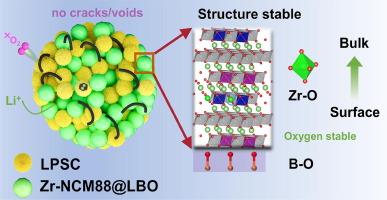通过调节表层与内层之间的氧活度实现高铝容量和长寿命硫化物全固态锂电池
IF 13.1
1区 化学
Q1 Energy
引用次数: 0
摘要
具有富氧化镍阴极的硫化物全固态锂电池(ASSLBs)因其卓越的安全性和能量密度,正在成为下一代可充电电池的主要竞争者。然而,由于阴极高活性表面氧与电解质之间的反应以及阴极中大量氧结构的不稳定性,采用富镍氧化物阴极的全固态电池存在性能下降的问题。在此,我们提出了一种协同改性设计方案,以调整从表面到体积的氧活性。LiBO2 涂层抑制了表面晶格氧离子的反应活性。同时,在体相中掺杂 Zr 可形成强 Zr-O 共价键,从而稳定体相晶格氧结构。这些改性的协同效应阻止了氧的释放,从而避免了阴极/SE 界面的降解。此外,通过调节表层到体层的氧活性,可建立一个高度稳定的界面,从而提高锂离子扩散动力学和阴极的机械稳定性。因此,采用这种协同策略改性的阴极在硫化物基 ASSLB 中表现出卓越的性能,包括 100,000 次的超长循环寿命、45℃ 时的超高速率能力以及复合阴极中 85% 的高活性材料含量。此外,ASSLB 还能在 82.82 mg cm-2 的高负载条件下稳定循环,实现 17.90 mA h cm-2 的等效容量。这些令人鼓舞的结果为 ASSLB 未来在快速充电、长循环寿命和高能量密度方面的实际应用铺平了道路。本文章由计算机程序翻译,如有差异,请以英文原文为准。

High-areal-capacity and long-life sulfide-based all-solid-state lithium battery achieved by regulating surface-to-bulk oxygen activity
Sulfide-based all-solid-state lithium batteries (ASSLBs) with nickel-rich oxide cathodes are emerging as primary contenders for the next generation rechargeable batteries, owing to their superior safety and energy density. However, the all-solid-state batteries with nickel-rich oxide cathodes suffer from performance degradation due to the reactions between the highly reactive surface oxygen of the cathode and the electrolyte, as well as the instability of the bulk oxygen structure in the cathode. Herein, we propose a synergistic modification design scheme to adjust the oxygen activity from surface to bulk. The LiBO2 coating inhibits the reactivity of surface lattice oxygen ions. Meanwhile, Zr doping in the bulk phase forms strong Zr–O covalent bonds that stabilize the bulk lattice oxygen structure. The synergistic effect of these modifications prevents the release of oxygen, thus avoiding the degradation of the cathode/SE interface. Additionally, the regulation of surface-to-bulk oxygen activity establishes a highly stable interface, thereby enhancing the lithium ion diffusion kinetics and mechanical stability of the cathode. Consequently, cathodes modified with this synergistic strategy exhibit outstanding performance in sulfide-based ASSLBs, including an ultra-long cycle life of 100,000 cycles, ultra-high rate capability at 45C, and 85% high active material content in the composite cathode. Additionally, ASSLB exhibits stable cycling under high loading conditions of 82.82 mg cm−2, achieving an areal capacity of 17.90 mA h cm−2. These encouraging results pave the way for practical applications of ASSLBs in fast charging, long cycle life, and high energy density in the future.
求助全文
通过发布文献求助,成功后即可免费获取论文全文。
去求助
来源期刊

Journal of Energy Chemistry
CHEMISTRY, APPLIED-CHEMISTRY, PHYSICAL
CiteScore
19.10
自引率
8.40%
发文量
3631
审稿时长
15 days
期刊介绍:
The Journal of Energy Chemistry, the official publication of Science Press and the Dalian Institute of Chemical Physics, Chinese Academy of Sciences, serves as a platform for reporting creative research and innovative applications in energy chemistry. It mainly reports on creative researches and innovative applications of chemical conversions of fossil energy, carbon dioxide, electrochemical energy and hydrogen energy, as well as the conversions of biomass and solar energy related with chemical issues to promote academic exchanges in the field of energy chemistry and to accelerate the exploration, research and development of energy science and technologies.
This journal focuses on original research papers covering various topics within energy chemistry worldwide, including:
Optimized utilization of fossil energy
Hydrogen energy
Conversion and storage of electrochemical energy
Capture, storage, and chemical conversion of carbon dioxide
Materials and nanotechnologies for energy conversion and storage
Chemistry in biomass conversion
Chemistry in the utilization of solar energy
 求助内容:
求助内容: 应助结果提醒方式:
应助结果提醒方式:


